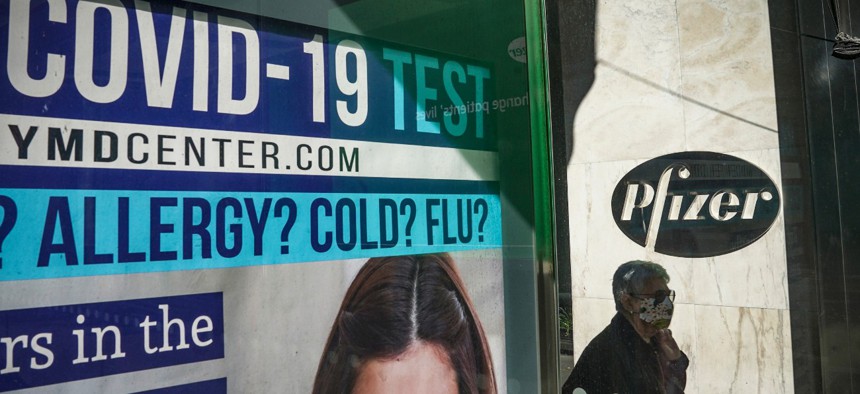
A bus stop ad for COVID-19 testing is shown outside Pfizer world headquarters in New York on Nov. 9. Pfizer has one of several promising coronavirus vaccine candidates. Bebeto Matthews / AP
Several Federal Agencies to Deliver COVID-19 Vaccines to Employees Directly
The agencies will receive their own allocations of the immunizations and then distribute them to their workforces.
Some federal agencies will create their own distribution networks to ensure their employees receive COVID-19 vaccines, according to Trump administration planning documents.
The departments of Defense and State, as well as the Veterans Affairs Department’s Veterans Health Administration, the Bureau of Prisons and Indian Health Service, will all receive a direct allocation of vaccines from the Centers for Disease Control and Prevention. The plan was spelled out in a COVID-19 Vaccination Program Interim Playbook, which was first reported by CNBC.
Vaccine distribution will take place in three phases based on population prioritization and the availability of doses. The document did not say specifically when the federal agencies would begin vaccinating employees, but it did list several of their relevant occupations as part of the first phase. CDC is relying in part on guidance on the “essential critical infrastructure workforce” created by the Cybersecurity and Infrastructure Security Agency earlier this year. After agencies receive vaccine allocations from CDC, they will likely have leeway to interpret federal guidelines and determine which employees get the immunizations first.
Defense will distribute the COVID-19 vaccine directly to all of its personnel, both civilian and military. Department contractors, retirees and dependents of active duty personnel for all services but the Coast Guard will also receive the vaccine from Defense. The administration has not yet made a determination for Reserves and National Guardsmen.
A Defense official said the department submitted a combined response with other agencies to complete the Federal Entity Plan for COVID-19 vaccine distribution.
At VA, all employees—including volunteers and trainees—at VHA facilities would receive the vaccine from their department. VA announced last week it would carry out a “limited-supply phase” for distribution followed by a “general implementation phase,” though it did not say whether all employees would be included in the first phase. Tribal nations that previously selected the Indian Health Service for vaccine allocation would receive it from CDC.
The plan lists the agency as only “potentially” including its own staff for vaccine distribution, but a separate, internal IHS plan released on Monday suggested the agency would distribute immunizations to tens of thousands of health care and other essential workers. An IHS spokesperson declined to comment on whether that population would include all of the agency’s 14,000 workers, but the internal plan provided instructions for at least some employees to receive the vaccine.
“Ensuring an equitable and transparent distribution plan when a vaccine is available is a priority for IHS,” an agency spokesperson said. “Operation Warp Speed will allocate vaccine doses directly to the IHS, and we will implement Advisory Committee on Immunization Practices recommendations on prioritizing our populations for vaccination.”
Front-line health care workers will be the very first to receive the vaccine as part of Phase 1-A of the distribution plan, according to CDC documents and officials.
Officials at the CDC’s Advisory Committee on Immunization Practices said at a meeting on Monday that research has demonstrated it is more effective to prioritize vaccinations for health care workers rather than patients. They added that 40 million vaccine doses—or enough immunizations for 20 million individuals, as a full dose requires two shots—could be available in December.
All domestic civil service employees at the State Department are slated to receive the vaccine from their employer, as well as any personnel eligible to receive care through the department. The Federal Bureau of Prisons, the Justice Department component that runs all federal prison facilities, would provide vaccines to all staff and inmates under the interim plan. Employees and inmates at private contract facilities are not slated for inclusion. In a recent memorandum for staff obtained by Government Executive, the bureau said employees, rather than inmates, would receive "initial allocations." CDC will determine the size of that allocation. The memo also provided a glimpse into the process federal workers will follow to receive a vaccine from their agencies: staff will follow a specific link that will allow them to register and, once registered, they can set up an appointment at their facility's health services department.
Spokespeople at all five agencies, as well as at CDC and the Office of Management and Budget, declined to say or did not respond to inquiries into the potential timelines for CDC sending vaccines to their federal partners. CNBC reported the agencies have told employees they can expect vaccines within the next eight weeks, though the Food and Drug Administration has yet to authorize any vaccine for use. Pfizer, Moderna and AstraZeneca have all reported successful results from human trials of their vaccine candidates. CDC said in its interim plan that large employers like the federal agencies tapped to receive their own vaccine distributions could use their internal occupational health settings to deliver the doses to their workers.
More federal employees could also become eligible for immunization before the vaccine is made available to the general public. CISA’s guidance on “essential critical infrastructure workers” includes as part of that definition federal government employees “who support mission essential functions and communications networks.” It also covers workers who support the “essential services required to meet national security commitments to the federal government and U.S. Military.” That includes those working in aerospace, nuclear matters, related software engineering and IT support, and several other vocations. “Essential workers” are slated to receive vaccines in Phase 1-B under CDC’s plan.
NEXT STORY: Retirement Gets Real: The Final To-Do List







